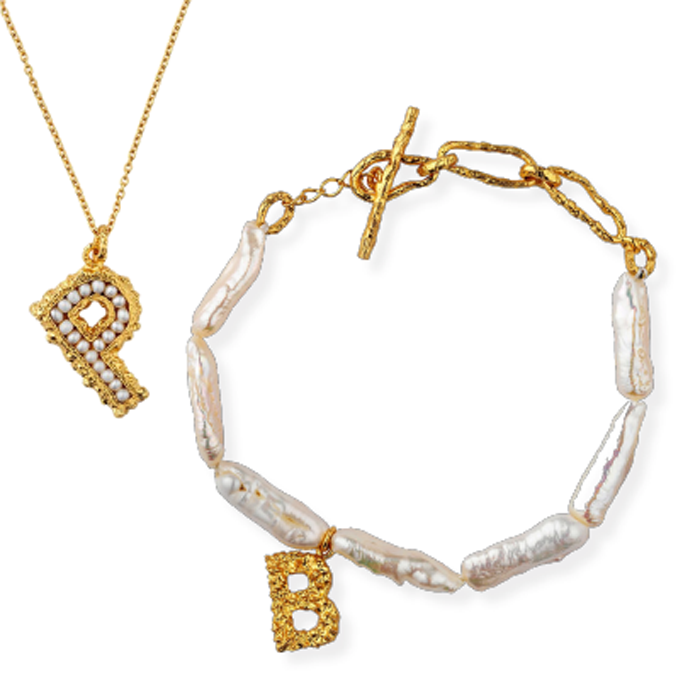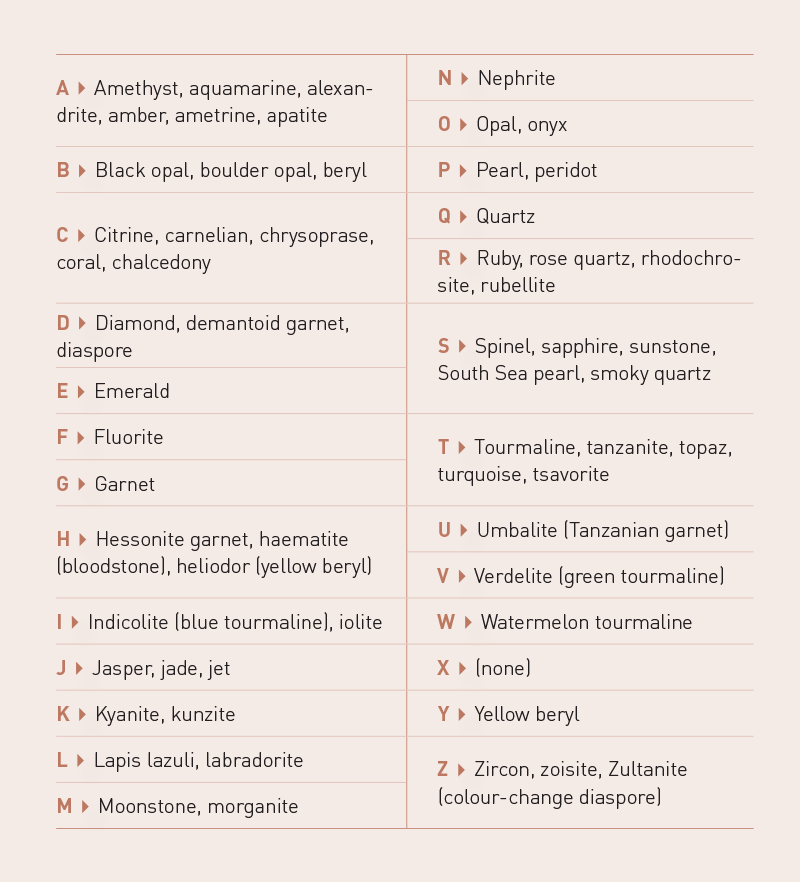Central to the wearing of jewellery is the element of personalisation: the ability of precious gemstones and metal adornments to signify the unique attributes of the wearer.
Before recorded history, humans wore jewellery to express elements of their identity, from cultural affiliation to social status, occupation, and interpersonal bonds.
Today, jewellery serves the same purpose – and perhaps nowhere is this more apparent than in the personalised jewellery category.
Current personalised jewellery trends – from birthstone and zodiac jewellery to initial pendants and signet rings – have deep historical roots, yet remain relevant to consumers by appealing to the innate desire to express oneself.
Birthstones and zodiac jewellery
Some scholars trace birthstone jewellery – like astrology – back to ancient Hindu traditions, which associated gemstones with nine ‘celestial forces’.
 |
| Above: Jessie V E |
In Western culture, the 1st Century historian Josephus is often credited with connecting the 12 zodiac signs – Aries, Taurus, Gemini, Cancer, Leo, Virgo, Libra, Scorpio, Sagittarius, Capricorn, Aquarius, and Pisces – with the 12 gemstones said to have been embedded in Aaron’s breastplate in the Bible.
However, the trend of wearing gemstones correlated with one’s own birth month likely dates to 16th Century Europe.
By the Victorian era, from 1837–1901, birthstones were “considered the favourite stone of choice” for engagements, writes gemmologist C. Jeanenne Bell in Collecting Victorian Jewelry – and remained so, until they were superseded by diamonds in the mid-20th Century.
However, there was no consensus on the ‘official’ list of birthstones until 1912, when the US-based National Association of Jewelers formalised American birthstones for commercial and promotional purposes.
This list was modified in 1952 by the Jewelry Industry Council of America, with several stones added.
Further updates occurred in 2002 and 2016 as new gemstones became widely available and in demand with consumers.
Like birthstones, zodiac symbols are closely linked with personal identity – and share an ancient past. The Western zodiac is largely derived from the Greek philosopher Ptolemy’s 2nd Century work Tetrabiblos.
The Chinese zodiac dates back even further, potentially to the Zhan Guo period in the 5th Century BCE, and was formalised during the time of the Han Dynasty (between 206 BCE and 9 CE).
Zodiac jewellery first rose to mainstream popularity in the 1930s and again in the ’70s – the so-called ‘Age of Aquarius’, when the trend was embraced by Parisian jewellery houses – according to jewellery historian Marion Fasel.
Recently, the trend has become popular once again – in particular, pendants engraved or gem-set with Western zodiac symbols and/or their corresponding constellations.
Searches for the term ‘zodiac necklace’ steadily increased over the past four years, both in Australia and worldwide, according to Google Trends data.
“Zodiac jewellery peaked in popularity during the 1930s, the 1970s and today: all eras of great uncertainty,” Fasel recently told fashion magazine Porter.
“People look to the stars and want their jewelry to act as and a talisman during difficult, uncertain times.”
Celebrity endorsement has also played a role; models Gigi Hadid and Kendall Jenner are among the stars who have worn the trend, donning zodiac pendants crafted by US designer Mercii.
Meghan Markle, the Duchess of Sussex, frequently wears Taurus and Virgo zodiac pendants – the star signs of her son Archie and husband Prince Harry – created by Canadian jewellery brand Suetables.
Indeed, Markle has a well-documented love of personalised jewellery of all kinds; her custom-made Lorraine Schwartz eternity ring is set with a hidden peridot, sapphire, and emerald – the birthstones of herself, her husband, and son – and she has also donned Ecksand stacking rings with her family’s birthstones.
Additionally, Markle has given royal approval to another trend: the initial pendant.
 |
| L to R: Catherine Zoraida, Karen Walker, Foundrae, Tiffany & Co., Dolce & Gabbana, Ashley Zhang |
 |  |  |
Above: By Chari | Above: Gucci | Above: Mateo NY |
Initial pendants and signet rings
Markle famously donned a necklace featuring the letters ‘M’ and ‘H’, prior to her official engagement to Prince Harry. In 2019, Markle donned an ‘A’ necklace at Wimbledon in tribute to her then-newborn son, causing the website of its designer – Australia’s Verse Fine Jewellery – to crash.
Intriguingly, her late mother-in-law, Diana, Princess of Wales, donned a sterling silver ‘D’ choker in her youth – later upgrading to a large gold version when she rose to public prominence.
Historically, King Henry VIII’s second wife Anne Boleyn is perhaps the most famous royal wearer of initial jewellery, with her portrait – which hangs in London’s National Portrait Gallery – featuring a pearl ‘B’ necklace.
“Initialled jewelled pendants and monogrammed jewels were largely for rulers, royals, and the most powerful members of a court until the 19th Century,” Rebecca Selva, a jewellery expert and chief creative officer of jewellery brand Fred Leighton, told Town & Country magazine.
“As the 19th Century progressed and an emerging industrial and middle class grew, jewellery manufacturing grew to meet the demands of the burgeoning merchant and middle class.
“With the popularity of sentimental jewellery in the 19th Century, initial and monogrammed jewels were in great demand,” Selva added, noting that “the popularity of charms and charm bracelets in the 1920s and 1940s again allowed for the creation of a most individualised jewel, which of course included initial charms and pendants.”
Today, alongside Markle, Gwyneth Paltrow and Bella Hadid are some of the more high-profile celebrity wearers of initial pendants, donning designs by Foundrae and Burberry, respectively.
Similar to initial pendants, signet rings were once reserved for the aristocracy; specimens have been found dating to ancient Mesopotamia, Egypt, and Nubia, and a Persian king is noted as wearing a signet ring in the Bible.
Used in place of a signature, the rings were generally crafted in solid gold and engraved or set with carved gemstones or intaglios, which could be dipped in wax and pressed on documents.
A ring’s ‘identifying marks’ would generally be a coat of arms, monogram, family seal, or the wearer’s initials; indeed, the term ‘signet’ derives from the Latin term signum, meaning ‘sign’.
Beyond antiquity, signet rings saw a resurgence of popularity in the Middle Ages and Renaissance, according to historian Emily Stoehrer, of the Museum of Fine Arts, Boston.
By the late 19th Century, signet rings had largely moved beyond practical use and evolved into a “status symbol”, says jewellery historian Lori Ettlinger Gross.
“The tops of the rings had decoration or engraving [and] often were gem-set, or if they were metal intensive, they bore initials done in shallow-yet-decorative engraving.
“You could probably say that it was in the 19th Century that signet rings became more of a personal statement,” Gross explained.
While once reserved for men in the upper echelons of society, today the signet ring is enjoying more widespread appeal, with jewellery designers creating streamlined versions for unisex wear.
The signature flat face offers a variety of options for personalisation, beyond the classic coat-of-arms or initials, yet retains the traditional signet ring’s sense of power and authority – increasingly appealing to the modern woman.
Consumers have also moved beyond wearing the signet ring on the pinky, instead incorporating it as a stacking piece with jewellery on other fingers.
 |
| L to R: W. Rosado; Simone Rocha; Meghan, Duchess of Sussex; Gwyneth Paltrow; Cara Delevingne. Top: Shay Fine Jewelry |
 |  |  |
Above: Monica Vinader; Karen Walker | Above: Pacharee | Above: Carolina Bucci |
Modern personalisation
Recent years have seen the rise of what consultancy firm Deloitte terms “mass personalisation”.
In the 11th edition of its Consumer Review report, Made To Order: The Rise of Mass Personalisation, Deloitte analysts write, “Empowered by social networks and their digital devices, consumers are increasingly dictating what they want, when and where they want it.
“As society becomes more affluent, the demand for personalised products and services will continue to increase as manufacturers seek to satisfy consumers.”
Deloitte research indicated that in some categories, more than 50 per cent of consumers expressed interest in purchasing personalised products or services, with a majority willing to pay more – “particularly in the more expensive or fashion-related categories.”
In jewellery, birthstones, initials, and zodiac symbols immediately give pieces a deeply personal quality to which consumers respond; there is a throughline between the simple initial necklace or birthstone ring back to the traditions of the past.
At the same time, jewellers can offer an affordable personalisation service by adding custom elements inspired by these trends, such as engraving a zodiac symbol or embedding a tiny birthstone.
Beyond beauty, personalised jewellery affirms identity; and with consumers ever more drawn to the personal, custom, and unique, as well as open self-expression, personalised jewellery neatly dovetails with both modern tastes and ancient history.
HIDDEN MESSAGES
ACROSTIC JEWELLERY
 A lesser-known personalised trend that appears to be enjoying a resurgence is acrostic jewellery – also called ‘hidden message’ jewellery. Credited to the 18th Century Parisian jeweller Jean-Baptiste Mellerio, acrostic jewellery featured messages spelled out with the ‘language of gemstones’. Each gemstone corresponded with a letter of the alphabet – D for diamond, R for ruby, and so on (see modern version, below) – and would be set in rings or pendants to spell out words, such as ‘souvenir’ (French for memory or remember), ‘regard’, ‘love’, and ‘dearest’. French Emperor Napoleon Bonaparte reportedly commissioned several acrostic pieces for family members, and numerous antique examples from the Victorian and Georgian eras are available today. Modern versions of acrostic jewellery have been crafted by Cartier, Chaumet, and Verdure, among many others. Image above: Jean-Baptiste Mellerio and Antique acrostic jewellery, 1stDibs |
read emag